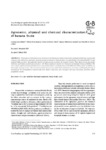Please use this identifier to cite or link to this item:
http://www.alice.cnptia.embrapa.br/alice/handle/doc/963274| Title: | Agronomic, physical and chemical characterization of banana fruits. |
| Authors: | MATTOS, L. A.  AMORIM, E. P.   COHEN, K. de O.   AMORIM, T. B. de   SILVA, S. de O. e   |
| Affiliation: | Lorena Alves Mattos, UEFS; EDSON PERITO AMORIM, CNPMF; KELLY DE OLIVEIRA COHEN, CPAC; Tamyres Barbosa de Amorim, UFRB; Sebastião de Oliveira e Silva, CNPMF. |
| Date Issued: | 2010 |
| Citation: | Crop Breeding and Applied Biotechnology, Londrina, v. 10, n. 3, p. 225-231, set. 2010. |
| Description: | Banana is the second most consumed fruit in Brazil, second only to orange. In relation to its social role, the crop is exploited by rural small-scale enterprises, ensuring the labor retention and recruitment in the country, representing a source of continuos income. Brazil is the fourth largest producer of banana , with a production of 7.0 million tons in 2007, in na area of approximately 500´000 ha. In the same period, India produced 11.7 million tons on 400´000 ha (FAO 2010). The low productivity in Brazil is a result of the lack of commercial varieties that combine short stature, drought and cold tolerance, good post-harvest characteristics and and pest resistance (Silva et al.2002 a). Typically, banana production is based on triploid cultivars, although diploids are important as allele sources for resistance/tolerance to biotic and abiotic factors (Jenny et al. 1999). Banana breeding programs with these genotypes, which are crossed with commercial triploid cultivars, have generated promising tetraploid hybrids with good performance for the agronomic traits of interest and high physical and chemical fruit quality ( Silva et al. 2002a). The information of the agronomic, physical and chemical characterizaton of banana fruit is useful both for the choice of parents for crosses, and in the seletction of diploid elites for the development of improved hybrids. The objective of this study was to characterize the agronomic, physical and chemical characteristics of 26 diploid, triploid, and tetraploid banana accessions. |
| Thesagro: | Banana |
| Keywords: | Musa spp Functional compounds Bunch weight Yield Cultivar Componente functional Variety |
| Type of Material: | Artigo de periódico |
| Access: | openAccess |
| Appears in Collections: | Artigo em periódico indexado (CPAC)  |
Files in This Item:
| File | Description | Size | Format | |
|---|---|---|---|---|
| mattosla012010.pdf | 1,86 MB | Adobe PDF |  View/Open |









